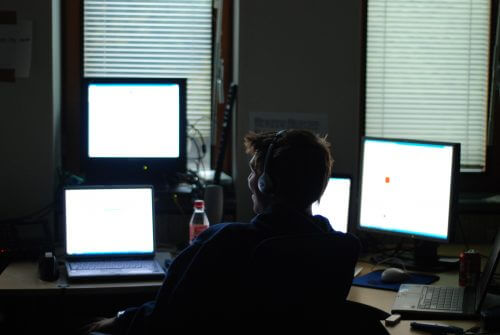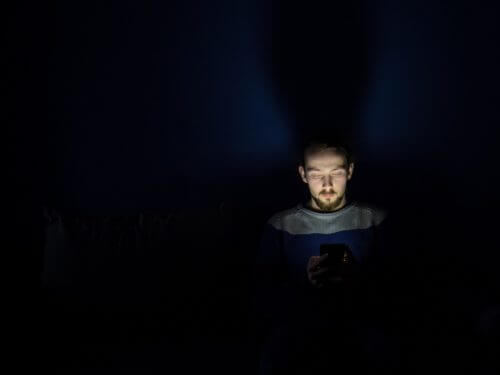Why electronic devices keep us awake at night and what can be done about it

About ten years ago she decided Lorena Herf, a software developer from Los Angeles, to try her hand at oil paintings. She and her husband, Michael, also a programmer, installed bright fluorescent lights in the attic of their apartment so that Lorna could paint in it at night and still get a sense of what the colors would look like in daylight. Late one evening, Lorna went down to the living room, where the computer screens were glowing. Now, as she became sensitive to changes in lighting, she noticed the stark contrast between the bright light of the screens and the warmth emitted by the glow bulbs that surrounded them. She remembers thinking that the electronic screens looked "like little windows of artificial daylight," which spoiled the pleasant atmosphere in the room.
The technology-loving couple developed a sophisticated solution to reduce the discrepancy. They created software that changes the number of photons emitted from the computer screen and their wavelength as the day goes by. The Herf couple's goal was to imitate as accurately as possible the natural fluctuations in light, starting with the bright, bluish-white light that characterizes the morning and afternoon light, and ending with the dim, orange light of the evening.
At first they just wanted to make the lighting in their home more harmonious. But they soon began to suspect that their new app, called f.lux, may also provide health benefits. "After using the software for a period of time, we started to notice that it was easier to relax in the evening," Lorna recalls, so it was easier for them to fall asleep after turning off their electronic devices. Since the couple published f.lux in 2009 and offered it for free, it has been downloaded more than 20 million times.
Thanks to their aesthetic preferences, the Herf couple made a strange discovery about how our bodies regulate our night's sleep. Researchers have known for several decades that strong light of any kind can suppress the hormone level Melatonin, the hormone that the brain produces at night to induce sleepiness. But more recent research shows that blue light suppresses melatonin more effectively than any other wavelength in the visible range, and may keep people alert even when they should be starting to feel drowsy.
As luck would have it, cell phones, computers and other electronic screens became brighter and bluer in recent decades due to the development of powerful blue LED lamps. During the day, when blue light is already abundant, the addition of blue light as a result of exposure to electronic screens is not expected to greatly affect our physiology. The problem is that more and more people are staring at bright screens deep into the night.
Almost everyone who participated in the survey she conducted American Sleep Association In 2011, for example, used a television, computer, cell phone, or other similar device during the hour before bed at least a few nights a week. In 2014, the association determined that 89% of adults and 75% of children in the US have at least one electronic device in their bedroom, and a high percentage of them send or answer text messages even after they have already fallen asleep once. Such studies have encouraged engineers and programmers to try and develop different solutions to prevent an already sleep-deprived population from losing additional hours of sleep because of the electronic devices. The solutions range from glasses with colored lenses to natural lighting systems for home and office.
"If a way is found to simulate the change of natural lighting during the day, it will be perfect," he says Christian Keijuken, head of the Center for Chronobiology at the University of Basel in Switzerland. "Ideally we will have the same lighting indoors and outdoors." But it is still unknown how effective these solutions are, especially when you can simply turn off the devices.
too good
In the past, the light emitted from electronic devices did not significantly affect the quality of sleep. The harm to the quality of sleep began in 1992 with the invention of the bright blue LED light in Japan. By combining the new blue LED bulbs with the older, green and red bulbs, or by coating the blue LED with materials that emit light at other wavelengths, the technological product manufacturers were able to produce white LED light with a full spectrum for the first time. Because LEDs are much more economical than other types of bulbs, they soon found their way into televisions, computer monitors, tablets, and certain e-readers, flooding the home and office with a much brighter blue light than before.
Researchers only began accumulating solid evidence that blue light might disrupt sleep about 15 years ago, but they've been figuring out what the mechanism might be for a long time. Scientists discovered already in the 70s of the 20th century that a tiny area of the brain, called the suprachiasmatic nucleus (SCN), helps in the regulation and control of the sleep cycle, alertness, body temperature and other indicators that change during the day. Studies have shown that the SCN encourages the The pineal gland The brain produces melatonin every evening.

Earlier in the 21st century, biologists deciphered exactly how this signal transmission process occurs. It turned out that the missing link was a type of light-sensitive cell in the human eye, which was unknown until then, different from The familiar reeds and gauges, responsible for night vision and color vision respectively. This third light receptor monitors the amount of blue light in the environment and reports to the SCN. Thus, when there is a lot of blue light (for example, when the sun is in the center of the sky), this particular cell causes the SCN to command the pineal gland to reduce melatonin production, and we stay awake. But when the sun starts to set, the amount of blue light decreases, and the result is a burst of melatonin that causes us to fall asleep.
One of the studies that provides evidence that blue LEDs in screens may confuse the brain at night is a 2011 study conducted by Keijuken of the University of Basel and his colleagues. In this study, volunteers who were exposed to an LED-lit computer screen for five hours in the evening produced less melatonin, felt less tired and performed better on alertness tests than volunteers who sat in front of a fluorescent screen of the same size and light level. similarly, 2013 study של Mariana Figueroa from Rensselaer Polytechnic Institute, showed that just two hours of activity with an iPad in the evening is enough to prevent the normal nocturnal increase in melatonin. and in an experiment that lasted two weeks at Brigham and Women's Hospital in Boston, and its results were published in 2014, it was found that volunteers who read on an iPad for four hours before bed reported feeling less tired, took an average of ten more minutes to fall asleep, and slept easier compared to those who read a regular printed book at night. Keijuken and others have also shown that these effects are especially strong in teenagers and young adults, for reasons that are not yet clear.
in a new light
Following the accumulation of evidence that artificial screens in general, and blue light in particular, harm sleep, scientists began to investigate different solutions. Some studies have shown that glasses with orange plastic lenses, which filter the blue light emanating from electronic devices, help prevent suppression of melatonin. Similar glasses are now available for purchase at prices ranging from $8 to $100. A more expensive option is what is known as a dynamic lighting system, which promises to create "the full range of daylight within an interior space" that sells for several hundred to thousands of dollars, depending on the size of the home or office.
The cheapest solutions are computer software like f.lux. In March 2016, Apple added an application for the iPhone and iPad called Night Shift. The application works similarly to f.lux and shifts the light waves emitted from the screen "toward the warm side of the spectrum" approximately at sunset. So far, these programs have not been studied in a controlled study, but Figueroa says she is planning one, and Michael Herf says he is collaborating with scientists at the university to test the impact of f.lux in everyday life outside the lab. "For me, f.lux is still a hypothesis," says Herf. "We believe that software is probably helping a lot of "night birds", but these case stories still need to be supported with data."
However, researchers emphasize that eliminating the blue light is not a complete solution. Even dim orange screens make it easier for us to stay up at night and read, watch movies or play computer games, keeping our brain alert while it should be relaxing. "It's like being in complete darkness but drinking coffee," explains Figueroa. "Coffee will still have an effect."
In the end, the safest solution is electronic avoidance: closing all screens and bright lights at least a few hours before bed. It is impossible to escape the fact that humans have developed during evolution to wake up when the sun rises and go to sleep when it sets. "Before we had all this technology, before electricity and artificial lighting, we would wake up in the daylight, sit around the fire for a bit at night, and go to sleep," she says Debra Skeen, a chronobiologist at the University of Surrey in England. Artificial lighting has provided enormous benefits over the years. But there are times, especially at the end of the day, that these benefits are exaggerated.

2 תגובות
You can adjust the color on each screen towards red and solve the problem, choose an orange-red background instead of blue-green...